Drowning fatalities on the rise in Ontario, experts say
Professionals offer life-saving tips on water safety

There have already been 54 drowning related fatalities in Ontario this year. That's six more thanthis time last year, according to preliminary statistics gathered by the Lifesaving Society.
Three apparent drownings occurred in the last week alone.
- School board's swim test protocol unclear days after student's death in Algonquin Park lake
- Bodies of 2 men in 20s pulled from water after apparent drowning at Wasaga Beach
Barbara Byers, the public education director of the Lifesaving Society cautioned anyone out enjoying the water to be vigilant. "A drowning can happen in seconds, and it's silent," she said."Someone screaming for help as they slip beneath the water is 'very Hollywood.'"
"When someone is drowning, their airway fills with water so you're not going to hear 'Help!'" she said."The transition from someone happily swimming and enjoying the water to drowning is so subtle."
Most drownings happen to people who just get in the water for a swim. Byers said the most important thing to keep in mind when swimming is to be self-aware about your capabilities. Don't push your boundaries, especially if you're an inexperienced swimmer.
And never, ever panic.
"Panicking takes a lot of energy. If you're nervous about where you are, just calm down and the best thing to do is float on your back," Byers advised. "As long as you get your airway out of the water, just float on your back, calm down, get recharged and then start swimming back to safety."

Another leading cause of drowning fatalities is boat-related incidents. Byers said that dangerous marine situations usually arise from twoeasily avoidable types of risky behaviours:not wearing life-jackets and drinking alcohol on board.
80 percentof boating fatalities involve people who don't have a life-jacket on.
"A life jacket buys you time. If you have it on and you fall in, then you can get yourself either back to safety or it gives you time for someone to help you," said Byers.
Alcohol on the other hand"affects your abilities to make decisions, to make judgements.It affects your balance, your abilities to navigate a boat," Byers said."Just don't do it."
But this message doesn't just apply to operating a marine vehicle. Alcohol is suspectedto have been a factor in another drowning fatality earlier this year in Toronto.
Oliver Nicholls is a head guard with the Toronto Police Lifeguard Service at Cherry Beach. He said he has to jump in most often when people swim out beyond the buoys.
"The beach can be unpredictable, there can be dropoffs, areas where the water might drop, or there might be a current and it might pull you out a little bit," said Nicholls. "Being confident to know that you can swim back is important. But if you're not, don't be afraid to call out for help."

Steven Oung andAbhishek Ranjan visit Cherry beach to train for an upcomingtriathlon. Oung said that open waters are a much bigger challenge than indoor swimming.
"You can't swim as fast as you would in a pool. You have to take your time, pace yourself, make sure you're going in the right direction," he warned. "You don't want to go too far out, just because of any currents that might pull you in."
Oung added that he "always swims with a buddy" and warns swimmers to "never go at it alone. Always stay close to the shores, and always make sure the lifeguard knows you're swimming."

"Have a wetsuit, it's cold water. You can't stay in for too long without a wetsuit. You may get hypothermia," added Ranjan.
Butwhetherindoors or outdoors, basic water safety protocols apply.
The sad thing, Barbara Byers said, is that "when I look at the statistics, I find that there are a number of behaviours that, if people were more thoughtful, more aware of, could bring down the number of drownings very low."
With files from Mathieu Simard












_(720p).jpg)


 OFFICIAL HD MUSIC VIDEO.jpg)
.jpg)



























































































